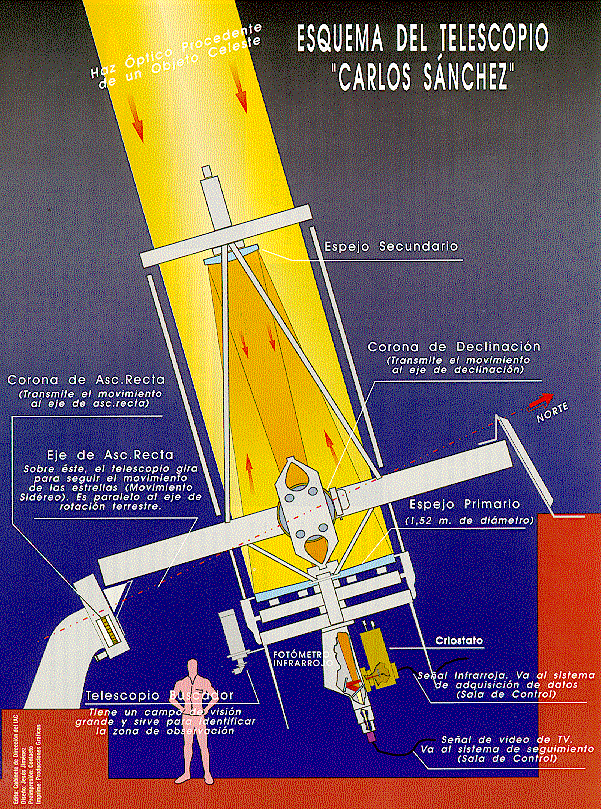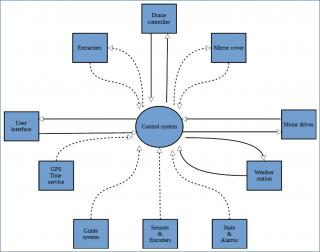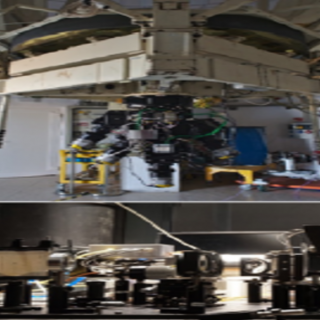Telescopio Carlos Sanchez


The Carlos Sánchez telescope is located in the IAC’s (Instituto de Astrofísica de Canarias) Teide Observatory. It has a primary mirror with diameter 1.52 meters and it is mainly setted for night observations in the infrared range. Its design and building was directed by Prof. J. Ring (ICSTM) in collaboration with other groups from the United Kingdom and IAC, commissioning in 1971 and starting service in 1972. It was originally designed as a low cost flux collector for infrared astronomy and it was one of the early telescopes with a thin mirror. After two years studying for the best place choosing between Tenerife, La Palma and Sierra Nevada, TCS was finally installed in Tenerife. The total budget of the telescope was only 58 000 pounds (about 70 000 euros). Surprisingly, TCS telescope is one of the largest telescopes in the world mainly setted for infrared astronomy nowadays.
In 1983 the original owner of the telescope, SERC (Science and Engineering Research Council), transferred its responsibility to the IAC and improvements in order to keep the telescope in a competitive status are performed. Actions carried out for this purpose take from creating technical services of Instrumental Maintenance and hiring observers to help along the observations, to automating control and data acquisition moved to an adjoining room converted into Control Room, installing instrumentation for common use and improving and optimizing general structure of the telescope to increase features in pointing precision and tracking.
Dr. Carlos Sánchez Magro, Astrophysic Professor at Universidad de La Laguna, in whose honor the telescope was named, was a prominent member of the Instituto de Astrofísica de Canarias since the beginning. He was born in Valladolid, in 1944, and died in Tenerife in 1985, only 6 days after the solemn opening ceremony of facilities and observatories in the IAC. He was the driving force behind infrared astronomy and teaching in the Universidad de La Laguna. His interest, enthusiasm and critical awareness pervaded the young generations in the IAC. His memory should be lasting.

FocusCassegrain (f/13.8)
Instrumentation
| Physical limits | values |
|---|---|
| North | Dec +64.55 deg |
| South | Dec -36 deg |
| East | AH -4.57 hours |
| West | AH +5.01 hours |
| Optical system | values |
|---|---|
| Primary-secondary distance | 135″ (3429 mm) in the secondary central position |
| Primary-equipment holder ring dist. | 22.25″ (565.15 mm) |
| Focus-equipment holder ring dist. | 49.75″ (1263.6 mm) |
| Floor-equipment holder ring dist. | 73.00″ (1854.2 mm) |
| Focal plane-secondary ratio | 20 mm focal plane displacement |
| 1 mm displac. sec. | 30″ image widening |
| Primary mirror | Secondary mirror | |||
|---|---|---|---|---|
| Reflecting surface geometry | Concave ellipsoid | Reflecting surface geometry | Convex sphere | |
| Diameter | 60″ (1524 mm) | Diameter | 371 mm (checked on 26/03/87) | |
| Hole diameter | 8″ (203.2 mm) | Curvature radio | 2925 mm | |
| Curvature radio | 9134.39 mm | Focus path | 140 mm (±70 mm) | |
| Conic constant | -0.712 | Weight | 16 kg | |
| Weight | 512.5 kg | Transmission weight (without mirror) | 10 kg |
The name of the telescope was adopted in honour of Prof. Carlos Sánchez Magro, Astrophysics Professor at the University of La Laguna, Prof. Carlos Sánchez was a very distinguished member of IAC since its origins. He was born in Valladolid in 1944 and died in Tenerife in 1985, unfortunately only 6 days after the solemn inauguration of the IAC´s facilities and observatories. He was a tireless promoter of Infrared Astronomy and Astronomy teaching.
The TCS is suitable to observe ""cold"" objects, like stars in the first or last stages of their evolution. Some of the first infrared images of the impact of the P/ Shoemaker-Levy9 comet on Jupiter and some images of sub-stellar objects like G196-3B, were obtained with it. Sometimes, the TCS operates together with other telescopes, mainly in the OT (OGS and IAC80), for complementary observations in different wavelengths or for investigations of the atmospheric structure.
The TCS has been used for a wide range of infrared observational programmes, from large-scale Galactic Centre mapping to stellar oscillations. Altogether, the TCS has generated almost 250 refereed papers in international journals.
Some examples of results are:
1) The creation of a catalogue of galaxies with stellar formation in the H band of emission -first of this type- that includes 70 of such objects. This project has required an immense amount of observing time.
2) Photometry of asteroid 2002 NY40, that rapidly crossed the sky at a distance from the Earth of only 750,000 km.
A photometric study of the Orionis Sigma clusters in R, I and J bands with the Carlos Sánchez, OGS and IAC80 telescopes, identifying 50 low mass stars and brown dwarf candidates.

